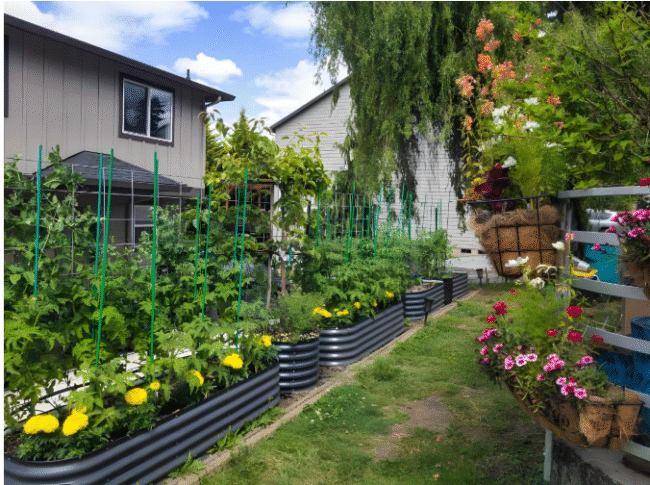Designing a vibrant, long-lasting flower bed requires more than just choosing beautiful blooms. It involves understanding plant characteristics, seasonal cycles, soil compatibility, and aesthetic harmony. Whether you are designing a flower bed for a residential garden, public landscape, or container space, selecting appropriate flowers will determine both visual appeal and maintenance success.

Resource: vegega.com
1. Key Factors in Selecting Flowers for a Flower Bed
Before choosing specific flower varieties, several environmental and practical considerations should guide your decision-making process:
a. Sunlight Exposure
Determine whether your flower bed is in full sun, partial shade, or deep shade. Some flowers thrive in direct sunlight for at least 6 hours per day, while others prefer cooler, shaded conditions.
b. Soil Type and Drainage
Well-draining soil rich in organic matter is ideal for most flowering plants. Conduct a basic soil test to determine pH and nutrient levels, and amend the soil accordingly with compost or peat moss.
c. Climate and Hardiness Zone
Refer to your USDA Hardiness Zone to choose perennials and annuals suited to your local climate. Some flowers are more frost-resistant, while others thrive in warm, dry regions.
d. Flowering Period
For a continuous display of color, mix early, mid-season, and late-blooming varieties. This staggered approach ensures your bed remains attractive from early spring through late fall.
e. Height and Spread
Choose a variety of plant heights to create depth and dimension. Taller flowers should be planted at the back of the bed or in the center of island beds, while shorter plants should edge the borders.
2. Best Annual Flowers for Flower Beds
Annuals are popular choices for metal raised garden beds due to their fast growth, vibrant colors, and ease of replacement. They complete their life cycle in one growing season and offer instant visual impact.
a. Marigolds (*Tagetes spp.*)
Marigolds are sun-loving and low-maintenance, making them ideal for beginner gardeners. Their bright yellow and orange blooms deter pests, particularly aphids and nematodes, making them a practical companion for vegetable gardens.
b. Petunias (*Petunia spp.*)
Available in a wide array of colors, petunias bloom continuously from spring to frost. They thrive in full sun and well-drained soil, and their cascading growth makes them suitable for borders and containers.
c. Zinnias (*Zinnia elegans*)
Zinnias are heat-tolerant, drought-resistant, and come in a variety of shapes and colors. They attract pollinators like butterflies and bees, which are beneficial for garden biodiversity.
d. Impatiens (*Impatiens walleriana*)
For shaded flower beds, impatiens offer reliable blooms in pink, white, red, and purple. They require consistently moist soil and benefit from mulch to retain moisture.
3. Recommended Perennial Flowers
Perennials return year after year, offering structure and consistency to your garden design. Although they often take longer to establish than annuals, they are a long-term investment in both beauty and sustainability.
a. Coneflowers (*Echinacea purpurea*)
Coneflowers are hardy, drought-tolerant perennials that flourish in full sun and poor soil conditions. Their purple daisy-like blooms last throughout summer and are particularly attractive to bees and butterflies.
b. Black-Eyed Susans (*Rudbeckia hirta*)
Known for their golden-yellow petals and dark centers, Black-Eyed Susans bloom from midsummer to early autumn. These resilient plants tolerate heat, drought, and a wide range of soils.
c. Lavender (*Lavandula angustifolia*)
Lavender is valued for both its fragrant foliage and spikes of purple flowers. It requires well-drained soil and full sun and adds an element of elegance to any flower bed.
d. Daylilies (*Hemerocallis spp.*)
Daylilies are versatile and adaptable perennials that produce trumpet-shaped blooms in a range of colors. They tolerate drought and poor soil and can thrive in partial shade.
4. Bulb Flowers for Seasonal Impact
Spring-flowering bulbs add a burst of color when most other flowers are still dormant. They should be planted in the fall before the first hard frost.
a. Tulips (*Tulipa spp.*)
Tulips offer classic elegance in red, yellow, white, and even multi-colored varieties. Their structured form and early bloom time make them excellent for formal flower beds.
b. Daffodils (*Narcissus spp.*)
Daffodils are bright and cheerful flowers that naturalize well, returning each spring with minimal care. They are also deer-resistant, which makes them ideal for rural gardens.
c. Hyacinths (*Hyacinthus orientalis*)
With intensely fragrant blooms and dense flower spikes, hyacinths are perfect for smaller beds or entryways. They prefer full sun and well-drained soil.
5. Incorporating Native and Pollinator-Friendly Plants
Incorporating native flowering plants into your garden provides ecological benefits. Native species are well-adapted to local conditions and require less maintenance. They also attract native pollinators, supporting the broader ecosystem.
Examples include:
- Purple Coneflower (Echinacea)
- Milkweed (Asclepias spp.) – Essential for monarch butterflies
- Bee Balm (Monarda didyma) – A hummingbird favorite
- Coreopsis (Coreopsis spp.) – Long blooming and drought-resistant
6. Design Tips for a Cohesive Flower Bed
Beyond choosing appropriate plant species, the design and arrangement of your flower bed contribute significantly to its visual appeal:
- Color Harmony: Use complementary or analogous color schemes for a unified look.
- Repetition: Repeat key plants and colors to create rhythm and cohesion.
- Focal Points: Place larger or uniquely shaped flowers to draw the eye.
- Seasonal Rotation: Plan for seasonal change by incorporating both spring and summer-blooming varieties.
Conclusion
Choosing the right flowers for a flower bed involves a thoughtful balance of aesthetic preferences and environmental realities. By understanding the needs and characteristics of various annuals, perennials, and bulbs, you can cultivate a garden that is not only beautiful but also sustainable and easy to maintain. Whether you’re aiming for a cottage-style mix of wildflowers or a more structured formal arrangement, the diversity of suitable flowers ensures that every gardener can find the perfect match for their space and vision.
